A. To have constant bhav (Spiritual emotion) towards the Deities
The substances used in the ritualistic worship have constant bhav towards the Deities.
B. Feeling of gratitude
The substances used in the puja have constant feeling of gratitude towards the Deities with the thought that they have been given an opportunity to serve through the medium of puja as well as Arati (A ritual of waving a lit lamp in front of a Deity and Saints, accompanied by singing of hymns).
C. Intense desire to imbibe the Sattva component
The objects used in the puja have 100% intense desire to imbibe the Sattva component from the environment. That is why they are very dear to God.
D. Kshatravrutti (Attitude of a warrior)
The substances used in the ritualistic worship fight the Raja-Tama components and negative energies, if need be, in the subtle dimension. At that time by the grace of God various weapons are released by them.
E. Remaining constantly in satseva
All these substances do not move away from satseva even for a moment. They are forever ready to serve unto His Holy feet.
F. Offering everything unto the satseva of the Deities
Substances like the incense sticks, camphor and dhoop (Frankincense) can be used only once. In the course of satseva they offer everything at His Holy feet. Even the flowers are constantly in satseva till they wither.
G. Expansive thinking
All these substances, instead of keeping the received Sattva component to themselves, share it with others.
– (Through the medium of Ms. Madhura Bhosale, 16th January2005, 7.00 p.m.)
Articles related to puja,the proportion of benefit
conferred by them,the medium of purification and the body being purified
Component |
Benefit (%) |
Medium which purifies |
Body which gets purified |
| 1. Sindur (Vermillion) and raktachandan (Red sandalwood) |
10 |
Touch |
The physical body |
| 2. Ashta-gandha |
15 |
Smell |
The physical body |
|
3. Haldi (Turmeric) |
15 |
Smell |
The physical body |
| 4. Camphor |
20 |
Smell |
The praṇa-deha (Vital body) |
| 5. Bukka |
25 |
Touch |
The praṇamay-kosha (Vital energy sheath) |
|
6. Kumkum |
30 |
Divine Energy |
The mental body and the praṇamay-kosha |
| 7. Gandha (Sandalwood paste) |
30 |
Touch |
The mental body and the praṇamay-kosha |
|
8. Chanting (Going from many to one chant) |
100 |
At all levels at the same time |
Allbodies and sheathsfrom outer andinner side |
– A Scholar (Through the medium of Mrs. Anjali Gadgil, 2nd April 2007, 6.01 p.m.and 13th April 2007, 9.00 pm)

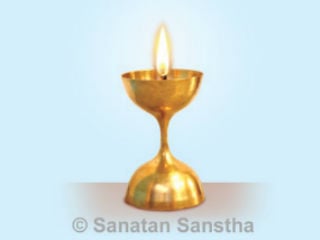 Waving a lit lamp symbolizes puja of Deity with Atmajyoti
Waving a lit lamp symbolizes puja of Deity with Atmajyoti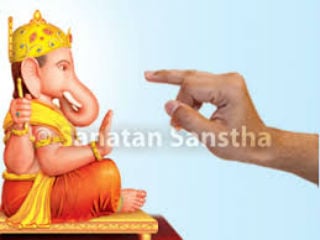 Benefits of applying gandha followed by offering of haldi and kumkum to Deities
Benefits of applying gandha followed by offering of haldi and kumkum to Deities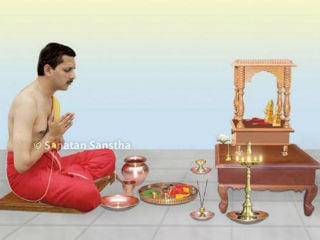 Shodashopachar puja – Means of abiding Dharma in a ritualistic and bhav enriched manner
Shodashopachar puja – Means of abiding Dharma in a ritualistic and bhav enriched manner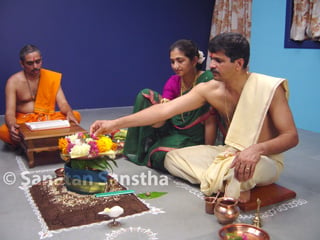 What are the benefits obtained from Puja preparations?
What are the benefits obtained from Puja preparations?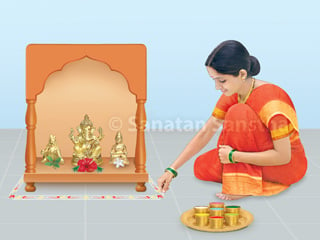 Importance of drawing Rangoli as a part of Puja preparations
Importance of drawing Rangoli as a part of Puja preparations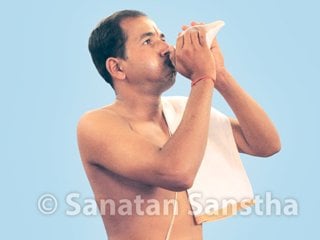 Sounding of a conch at the commencement of a puja
Sounding of a conch at the commencement of a puja